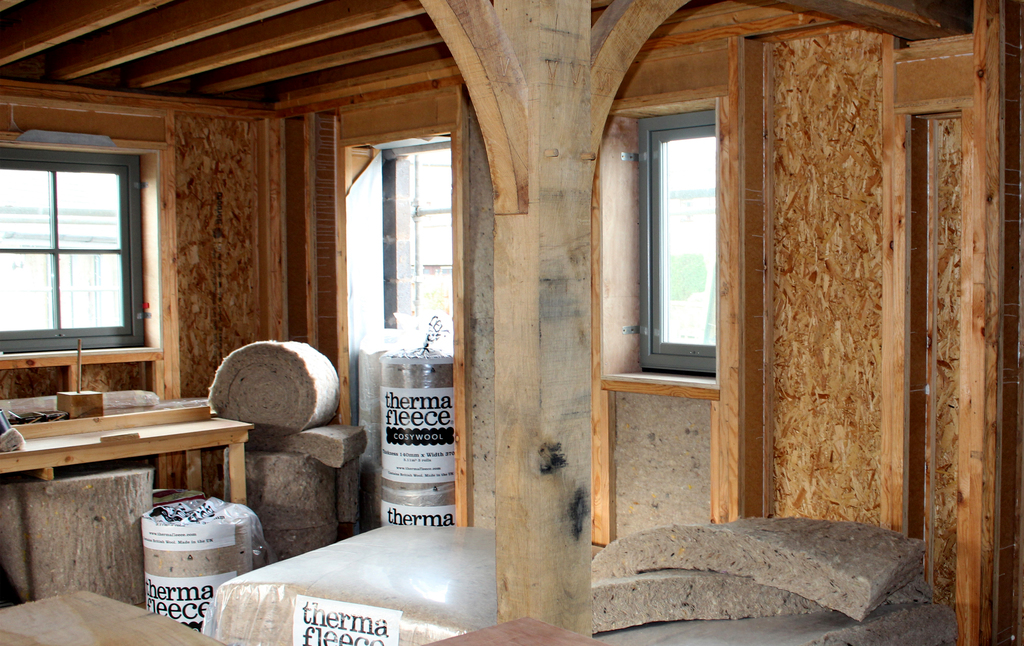Expert Advice - Environmentally Friendly Insulation
Share
Copy Link
With sustainability and energy efficiency being placed at the heart of so many home renovations, we are passionate about shining the spotlight on companies who are leading the way. So when we came across Eden Renewable Innovations, who manufacture thermafleece sheeps wool insulation; SupaSoft insulation made from recycled plastic; and Natrahemp an insulation rich in British Hemp, we wanted to find out more about environmentally friendly insulation and the benefits it can bring to your home.

Insulation by thermafleece
What are the options for environmentally friendly insulation?
There are many choices when it comes to sustainable insulation. The most common are sheep’s wool, wood fibre, hemp, recycled PET (polyester) and cellulose made from recycled newspaper. Sustainable insulation is available in a few different forms, ranging from flexible quilted rolls and slabs, rigid boards and blown-in loose fibres.
How does environmentally friendly insulation compare in performance with standard insulation products?
When considering insulation performance, it’s important to appreciate that insulation does more than prevent heat loss. Insulation provides protection from noise, it prevents overheating in the summer and helps regulate humidity levels in the building fabric. You may have to use a thicker layer of sustainable insulation to get the same thermal performance compared to some space age foams, however with natural fibre insulation in particular, you get much better all round performance across the other aspects.
Are there any other benefits in addition to the positive impact on the environment?
Thermally bonded insulation such as Thermafleece sheep’s wool and SupaSoft recycled PET will not sag or slump during service. This means that once installed they will last the life of the building, avoiding replacement and disposal issues. Natural fibre insulation provides excellent acoustic insulation helping improve sound quality within your home. Natural fibres are also breathable allowing the insulation to help regulate humidity levels within the building fabric.

Insulation by thermafleece
What are the main areas in the home where I should look to insulate?
Because heat rises, a large proportion of heat is lost through the roof so it is important to ensure your loft space is properly insulated. You will need at least 250mm of insulation laid between and over the rafters and you should ensure the insulation is in good condition.
In older properties, a lot of heat is lost from the ground floor. You should minimise draughts around the edges of the floor and if possible install insulation between the floor joists.
Insulating external walls is the most challenging and can lead to problems with condensation if done incorrectly, so you should speak with an insulation supplier if you are planning to insulate external walls.
What should I look out for in terms of measuring insulation performance?
Thermal conductivity is a measure of how well a material insulates against heat loss. The lower the thermal conductivity, the less heat escapes for a given thickness of insulation. This means that you need a thicker layer of insulation if the thermal conductivity of the insulation is higher. This isn’t a problem in loft areas where insulation can be layered thicker but in areas where space is limited it is better to use insulation with a lower thermal conductivity.
You should also be mindful that insulation performance is about more than preventing heat loss so very light synthetic foams may reduce heat loss but they provide little insulation against noise and are not breathable so if these considerations are important, synthetic foam insulation may not be appropriate.

Insulation by thermafleece
Will natural fibre insulation be effective in old homes?
Natural fibre insulation is often used in older properties because insulation such as Thermafleece sheep’s wool insulation is highly breathable. This will help regulate humidity levels and reduce the likelihood of damage cause by moisture build up within the building fabric. For well ventilated lofts vapour open insulation made using recycled PET such as SupaSoft is appropriate.
How long does environmentally friendly insulation last for?
Providing the insulation contains a binder it will last the life of the building. Allowance should be made for settlement in loose insulation; this can be achieved by installing a thicker layer of insulation or injecting the insulation at a higher density when insulating wall and rafter voids.

Insulation by thermafleece
Is natural fibre insulation biodegradable at the end of it's life?
The natural fibre component of insulation will degrade at the end life. It is better where possible to reuse or recycle insulation at the end of its life to make sure the carbon in the natural fibres remains locked up.
Can I install the insulation myself?
Insulation such as Thermafleece sheep’s wool and SupaSoft recycled PET can be safely handled and are easy to use. Most people can insulate their lofts easily and safely. You should refer to the manufacturer’s guidance. Insulating other areas such as walls and floors requires more careful preparation. You should seek advice before attempting this type of work yourself.
Anything else I need to know?
Insulation suppliers and distributors generally offer free help and advice so if you need to know anything they will be happy to help. Thermafleece and SupaSoft have dedicated technical help lines and are happy to speak with professionals, trades and end-users alike.
Published: January 24, 2019
Related articles

Your Guide - Heat Pumps
